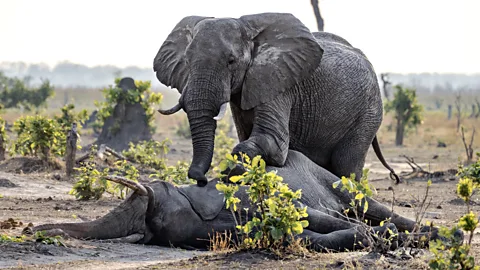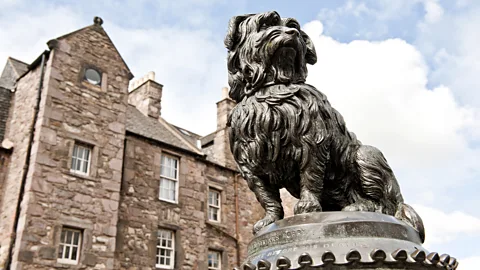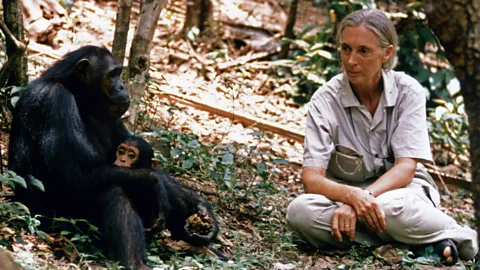Why some animals appear to mourn their dead
 Alamy
AlamyGrief has long thought to be a human trait, but other animals – from killer whales to crows – also appear to suffer loss when a companion dies.
Last week, a female killer whale was spotted off the coast of Washington State pushing the body of her dead newborn calf. The orca, known as Tahlequah, was observed doing the same thing in 2018 after another of her calves died in infancy. On that occasion, Tahlequah pushed the body of her offspring for 17 days, continually retrieving it and preventing it from sinking – an incredible feat given the fact that killer whales can travel an average of 120km (75 miles) a day.
Whales are not the only species known to carry the bodies of their deceased young. In 2021, Edinburgh Zoo reported that one of their chimpanzees, Lianne, had given birth to a stillborn baby and was refusing to let go, carrying the infant around with her within the zoo enclosure. Other highly intelligent mammals, such as dolphins and monkeys, have also been observed behaving this way.
"It's hard to see this behaviour without thinking of it through the lens of grief, partly because, as humans, if we lose someone we want to cling on to that person in some sense," says Becky Millar, a researcher specialising in the philosophy of cognitive sciences at Cardiff University.
"It seems to be a very literal manifestation of that kind of urge to retain bonds with the dead loved one."
 Alamy
AlamyAccording to Millar, what's notable about these cases is that these animals don't treat the deceased infant in the same way that they would treat a merely immobile, but live infant. This suggests that it's not just a matter of them not understanding that their infant is dead.
"There is some sort of tension where the animal isn't quite able to let go," says Millar. "It's like they're trying to grapple with this new world that they're faced with and trying to come to understand that loss."
There are signs that both humans and animals undergo this readjustment period. For example, Millar points to the fact that animals often search for their companions after their death, while humans also engage in what are called search behaviours following a bereavement, where they scan the environment for any sign of the deceased person.
Sometimes this behaviour can continue long after the death. Famous examples include that of Greyfriars Bobby, a terrier who spent 14 years guarding his owner's grave in Edinburgh, Scotland, and Hachiko, an akita dog that continued to wait for its owner at a train station in Japan long after his death.
There are also anecdotal stories of animals displaying acute distress after the loss of a close companion. There are reports that upon seeing their babies eaten by killer whales, for example, sea lion mothers wail pitifully in apparent anguish.
There are other examples too. In her book How Animals Grieve, anthropologist Barbara King also describes accounts of cats, dogs and rabbits crying and searching for their companions, and horses gathering around the grave of a member of their herd.
In 1999, an elderly female elephant at an Indian zoo reportedly died of grief after a young elephant she had befriended died during childbirth. The elderly elephant, Damini, was seen to shed tears over her friend's body, before she lost all interest in food and eventually starved to death.
 Getty Images
Getty ImagesIn 1972 Jane Goodall, an English primatologist who has studied chimpanzees in the wild for over 60 years, observed one young chimpanzee known as Flint showing signs of what in humans would be called clinical depression when his mother died. He stopped engaging in social interactions with his group, refused to eat, and eventually died a month later.
Even birds grieve, it appears. Austrian zoologist and ethologist Konrad Lorenz once described the response of greylag geese to losing their mate as "roughly identical with those accompanying human grief". The geese hung their heads dejectedly, lost interest in food, and became indifferent to the world around them.
There isn't just anecdotal evidence. Empirical studies also support the theory that some animals, at least, feel emotions akin to grief. Laboratory studies, for instance, show that infant primates faced with the sudden loss of their mother go through phases of grief characterised by wailing and crying, followed by a gradual detachment from the world. They no longer play with others, ignore new and exciting objects, and eventually curl up into a ball.
In another study, it was found that female baboons who had lost a close relative had increased levels of stress hormones, a response that is also seen in humans following a bereavement.
Some animals even appear to display ritualistic behaviours after a death, similarly to how humans would hold a funeral. Elephants are known to visit the remains of family members and strangers alike, touching and stroking their bones, and standing for long periods beside the skeleton in a manner akin to a vigil. Chimpanzees are also known to clean the mouths and bodies of the deceased animal. There's even anecdotal evidence that crows, magpies and ravens gather around the dead of their own, sometimes placing leaves or twigs close to the carcass.
"I was riding my bike with a friend some years ago, and there was a circle of four or five magpies surrounding a dead magpie," says Marc Bekoff, professor emeritus of ecology and evolutionary biology at the University of Colorado, Boulder.
"They were surrounding the corpse with their heads down, sort of lightly pecking at it. Then one flew off and brought some twigs and leaves. Another did the same, and then it was almost like a chorus where they stopped, slightly lowered their head, and flew off."
 Alamy
AlamyHowever, whether these behaviours truly count as grief depends largely on how you define the concept – a philosophical question that is hotly debated. In a recent article on the subject, Millar says that unlike sadness, which is usually fleeting, grief tends to be protracted, lasting for months or years. Another important element of grief is that it also seems to encompass many different emotions. "You might feel sadness, but perhaps also other emotions too like anger or even hope," says Millar.
Grief also seems to involve a complex process of coming to recognise your loss and its implications.
"Even if you explicitly know that someone has died, there might be another sense in which the loss hasn't yet been integrated into your world and into your habitual patterns of behaviour and thought," says Millar.
"So you might want to lay out a plate for them on the table, or you might still anticipate the sound of their car coming into the drive at 6pm, or that they'll be sitting on their favourite sofa and so on. In some sense you expect them to be there, even though you know that that person has died."
Some philosophers argue that, while some animals undoubtedly feel distress after losing a companion, true grief requires further cognitive capabilities that animals lack. These include the ability to understand the permanence of death, and a recognition that the individual will not be present for future events and milestones in your life.
However, Millar points out that this definition doesn't just exclude animals, it also excludes children and some adults.
"I don't think all human grievers grapple with the nature of mortality, or project themselves to a really distant future as part of their grief. Young children who suffer a bereavement are probably not able to fully comprehend their loss at that stage, but it would seem wrong to say that their grief is lesser."
In her article, Millar defines grief as more about learning in a more practical sense how to live in a radically changed world. She believes that this practical process of adaptation is something that could be open to animals as well, given that it doesn't require highly cognitive, intellectual forms of understanding. Ultimately, Millar believes that many animals are capable of feeling grief.
"I think that other animals can share their lives with one another in quite a rich way and their whole patterns of behaviour can come to hinge upon that other animal," says Millar. So when their companion dies, they too are forced to undergo this kind of protracted process of comprehension and relearning of their world."
--
If you liked this story, sign up for The Essential List newsletter– a handpicked selection of features, videos and can't-miss news, delivered to your inbox twice a week.
For more science, technology, environment and health stories from the BBC, follow us on Facebook, X and Instagram.
